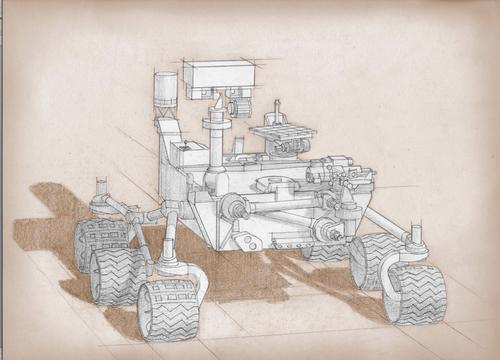NASA Could Switch From Looking For Support of Life On Mars To Searching For Current “Signs of Life”
It Came From Outer Space

A new team of 22 scientists have proposed the next step in the NASA Mars Exploration Program. The team is suggesting a new rover, which you can see illustrated above, that would be placed on Mars in 2020 and would shift the focus of research on the planet from determining if it can support life to searching for signs of life. The team, headed by John B. McNamee, Matthew T. Wallace, Ken Farley, and science definition team chair Jack Mustard, has issued a statement saying that,
Past Martian life seems possible, and we should begin the difficult endeavor of seeking the signs of life.
The team has four main objectives for their 2020 rover, described in their charter as,
A. Explore an astrobiologically relevant ancient environment on Mars to decipher its geological processes and history, including the assessment of past habitability and potential preservation of possible biosignatures.
B. In situ science: Search for potential biosignatures within that geological environment and preserved record.
C. Demonstrate significant technical progress towards the future return of scientifically selected, well-documented samples to Earth.
D. Provide an opportunity for contributed HEOMD or Space Technology Program (STP)participation, compatible with the science payload and within the mission’s payload capacity.
Essentially, the group wants to not only explore Mars in a way that emphasizes the search for signs of life, but do so in a way that provides samples from the planet that may open up new possibilities with future technology and analysis. The first item shows that the team plans to continue to explore whether or not Mars could ever support life, while the second and third items focus on the rover’s analysis on the planet, and ability to take samples before it returns to earth. The plan for the new rover reflects the change in NASA perspective, from the past on Mars to the present and future. According to Mustard, the new rover would have,
similar capabilities to the curiosity rover that is now on Mars, and land in the same way and be about the same size. And we are recommending that they equip that rover with instrumentation that allows it to explore the surface of Mars at one site, which will have relevance, both importance to understanding past habitability (the conditions necessary to sustain life) and to look for signatures or rocks that may hold signatures of biological significance.
Lindy Elkins-Tanton describes how the new, 2020 Rover would, unlike Curiosity, have to have a function to look at Mars on a microscopic level. Scientists would be looking for life at a microbial level, and would also like to add a function to the rover that would core and store rock samples to be brought back to earth for examination. Elkins-Tanton describes the need for sampling that can be brought back to earth, reasoning that the scientists can not operate with microscopic data alone,
because we can’t look with the kind of detailed understanding we’d have with laboratories here on earth.
The team even described how they would like to explore resources on Mars that could be used for human exploration of the planet, as fuel or other tools. Of course, that level of Mars exploration is looking forward quite a bit, but the proposal emphasizes exploration and sampling that would not only by applicable in 2020, but beyond.
Currently, the group plans to land the rover on Mars via the method tested with the fairly recent Curiosity Rover landing, with the same procedures. The rover would likely have a range of 3 to 12 miles on the planet’s surface, and would have the ability to collect around 31 1 cm diameter core samples, picked to best effect with the microscopic optical instruments, with a system like the prototype you can see below.
Jim Green, the NASA Director of Planetary Science Division for NASA in Washington, shared his thoughts on the importance of the project, which may be chosen as part of the open competition for new instruments on the 2020 rover, explaining that,
The Mars 2020 mission will provide a unique capability to address the major questions of habitability and life in the solar system.
(via i09, NASA and Jet Propulsion Laboratory Cal Tech)
- 15 Year Old Invents Body Heat Powered Flashlight
- Three Habitable Planets Discovered In Nearby Star System
- Young Scientist Talks Award Winning Quick-Charging Phone Battery On Conan
Are you following The Mary Sue on Twitter, Facebook, Tumblr, Pinterest, & Google +?
Have a tip we should know? tips@themarysue.com